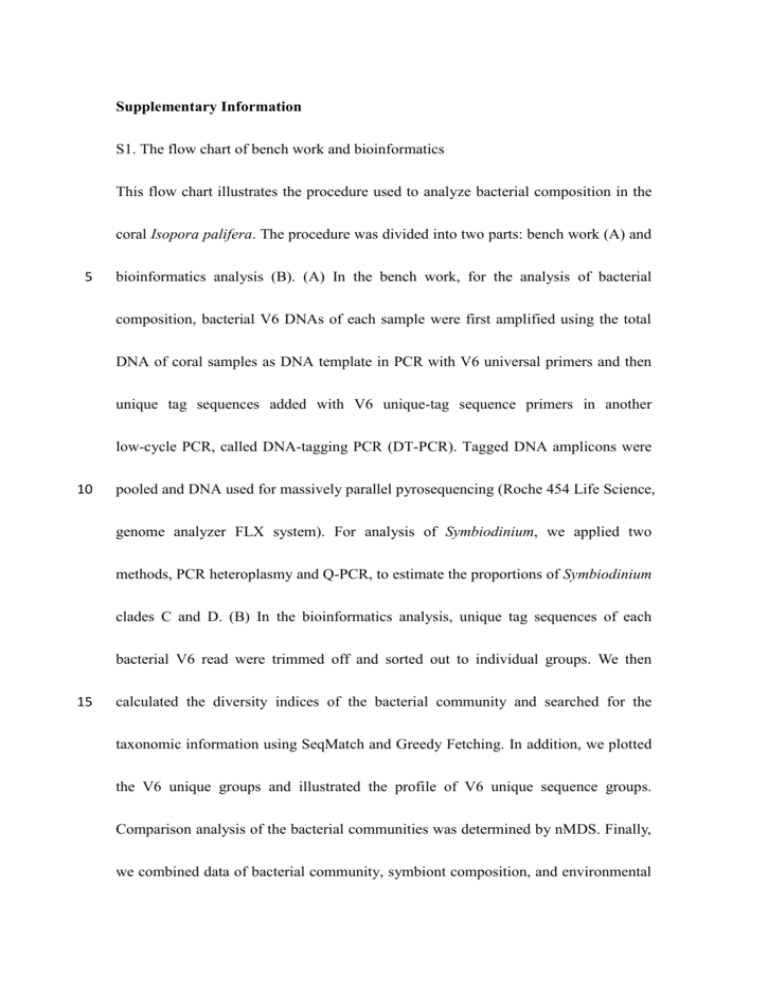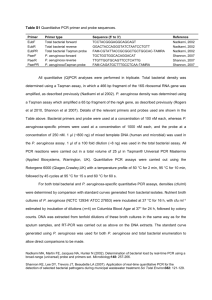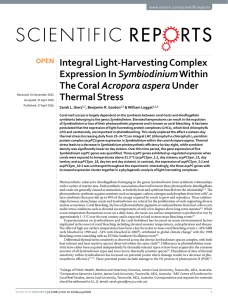Supplementary Information (doc 34K)
advertisement

Supplementary Information S1. The flow chart of bench work and bioinformatics This flow chart illustrates the procedure used to analyze bacterial composition in the coral Isopora palifera. The procedure was divided into two parts: bench work (A) and 5 bioinformatics analysis (B). (A) In the bench work, for the analysis of bacterial composition, bacterial V6 DNAs of each sample were first amplified using the total DNA of coral samples as DNA template in PCR with V6 universal primers and then unique tag sequences added with V6 unique-tag sequence primers in another low-cycle PCR, called DNA-tagging PCR (DT-PCR). Tagged DNA amplicons were 10 pooled and DNA used for massively parallel pyrosequencing (Roche 454 Life Science, genome analyzer FLX system). For analysis of Symbiodinium, we applied two methods, PCR heteroplasmy and Q-PCR, to estimate the proportions of Symbiodinium clades C and D. (B) In the bioinformatics analysis, unique tag sequences of each bacterial V6 read were trimmed off and sorted out to individual groups. We then 15 calculated the diversity indices of the bacterial community and searched for the taxonomic information using SeqMatch and Greedy Fetching. In addition, we plotted the V6 unique groups and illustrated the profile of V6 unique sequence groups. Comparison analysis of the bacterial communities was determined by nMDS. Finally, we combined data of bacterial community, symbiont composition, and environmental 20 factors to analyze their relationship using a cluster method. S2. DNA tagging PCR (DT-PCR) (A) Bacterial V6 DNA of each sample was individually amplified using the primers with unique tag sequences by 5-cycle PCR. Each unique tag sequence contained a 25 unique four nucleotide sequence at the 5’ end of the modified primers that allowed us to sort out sequencing reads. (B) After DT-PCR, every amplified DNA was checked by polyacrylamide gel electrophoresis. Band shift indicated a successful tagging reaction. 30 S3. ITS2 partial sequences of Symbiodinium clade C and clade D. There are two 3 bp indel mutations in the ITS2 regions of clade C and D. S4. Rarefaction curves of bacterial communities from individual coral samples. The OTU was determined by a cutoff value of 3% sequence similarity. 35 S5. The population dynamics of Gammaproteobacteria, Alphaproteobateria,and Cyanobacteria, in each coral colony. The y-axis is the population proportion of the bacterial group in the community, the x-axis is the sampling time. 40 S6. Example of Isopora palifera in Tan-Zi Bay (21°57'N, 120°46'E), Ken-Ting National Park S7. Symbiodinium population analysis by PCR length heteroplasmy (PCR-LH) Two populations of Symbiodinium clade C and D were determined by PCR length 45 heteroplasmy in detection of the ITS2 of Symbiodinium. Panel A shows the ITS2 PCR amplicons in Symbiodinium clade C and D. The bar chart presents the proportion of the two clade populations according to the band intensity (A), indicating that Symbiodinium composition varied in three different coral colonies (designated 351, 352 and 353) and different sampling months (B). 50 S8. Synchronous variation of the population dynamics of Bacilli and rainfall in the course of the study. The y-axis shows the population proportion of the bacterial group in the community, while the x-axis is the sampling month (from February to November in 2008). 55 S9. The environmental parameters at the sampling site from February to November in 2008. The parameters measured were seawater temperature, sunlight intensity, and rainfall. The seawater temperature and sunlight intensity changed significantly in April. Heavy rains occurred in summer (from June to August).











